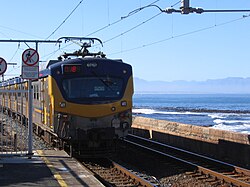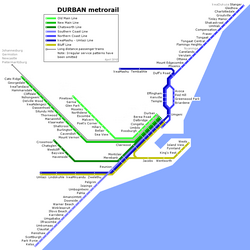Metrorail (South Africa)
 From Wikipedia - Reading time: 8 min
From Wikipedia - Reading time: 8 min

Metrorail is an operator of commuter rail services in the major urban areas of South Africa. It is a division of the Passenger Rail Agency of South Africa (PRASA), a state-owned enterprise which is responsible for most passenger rail services in South Africa. The Metrorail system consists of 471 stations, 2,228 kilometres (1,384 mi) of track, and carries an average of 1.7 million passengers per weekday.[1]
Metrorail was formed in 1996 as a business unit of Transnet and was transferred to the South African Rail Commuter Corporation (SARCC), the predecessor of PRASA. In the early-1990s Metrorail was placed under Spoornet, another business unit of Transnet but on 1 January 1997, Metrorail became an independent business within Transnet and the Metrorail regions were formed. In 2006 Metrorail was transferred back into the SARCC; in 2008 the SARCC became PRASA.

Regions
[edit]Because Metrorail operates services in several separate cities, for operational purposes it is subdivided into four regions.

- Gauteng region
Previously there were two regions: Witwatersrand in the south and Tshwane in the north. The southern area covers the Greater Johannesburg Metropolitan Area (also known as the Witwatersrand). Trains run from Johannesburg and Germiston outwards to Springs, Pretoria, Soweto and Randfontein via Krugersdorp.[2]
The northern part covers Pretoria and surrounding suburbs. Trains run from Pretoria station outwards to the various suburbs of the city, as well as southwards to Johannesburg via Kempton Park and Germiston stations (in the Witwatersrand region).[3]

- Durban region
This region covers Durban and the surrounding suburbs and towns. Trains run from Durban station outwards as far as Stanger on the north coast, Kelso on the south coast, and Cato Ridge inland.[4]

- Eastern Cape region
This region operates two separate lines in the Eastern Cape: one running from East London to Berlin, and one from Port Elizabeth to Uitenhage. Plans are in the pipeline to connect the service to Coega.[5]

- Western Cape region
This region covers the Cape Town metropolitan area and surrounding towns. Trains run from Cape Town railway station southwards to Simon's Town, southeastwards to Mitchell's Plain and Khayelitsha, and eastwards through Bellville to Strand, Stellenbosch and Wellington; occasional services run to Malmesbury and Worcester.[6]
Track and equipment
[edit]Metrorail trains, as with the rest of the South African rail network, run on 1,067 mm (3 ft 6 in) track. Some routes run on track owned and operated by PRASA; other routes run on track operated by Transnet and also used for long-distance and freight trains.
Most Metrorail services are operated by electric multiple unit train sets of the domestically built 5M2A type and the Japanese-built 8M type. Since 1999, the 5M2A trains are being refurbished. Everything above the underframe is completely removed, and replaced by new, prefabricated wall and roof modules.[7] In 2007 alone more than 300 coaches were refurbished.[8] The new trains are designated 10M3 (Cape Town), 10M4 (Gauteng) or 10M5 (Durban).[9][10]
The Metrorail services on the Eastern Cape are operated by four diesel trains, each consisting of ten coaches and a diesel locomotive.[11]
280 train sets operate on the system,[1] each able to carry up to 1,800 passengers.[12]
In October 2013, Gibela was awarded a contract to build 600 X'Trapolis Mega EMU trainsets (3,600 cars), the first half of a multi-phase rolling stock renewal program that would see up to 1,200 new trainsets delivered by the 2030s.[13]
Safety concerns
[edit]In the 2000s and 2010s, much concern was expressed about the safety of passengers on Metrorail trains, both due to crime and accidents.[14][15] Serious incidents include murders and assaults on-board trains, several level crossing accidents,[16][17] and a crash in Soweto.[18] An organisation called the Rail Commuters Action Group instituted a lawsuit against Metrorail and the government to force them to invest more money in security.[19] The case reached the Constitutional Court, which declared that Metrorail has "an obligation to ensure that reasonable measures are taken to provide for the security of rail commuters".[20] Despite this, safety on the trains remained a dire concern.[21]
Metrorail services also suffered from instances of arson of train-sets which occurred during passenger protests but not necessarily by disgruntled passengers,[22] in some cases forcing the closure of lines;[23] as well as incidents of cable theft disrupting services.[24]
In 2006, the Faure level crossing accident killed 19 people in a truck which had stalled on a level crossing.[25]
Improvement
[edit]Investment in the 2020s saw improvements to safety and service quality across the network, attracting travellers to rail, including some of the many who had stopped relying on trains due to substandard service and safety concerns.[26][27]
See also
[edit]References
[edit]- ^ a b "Metrorail". www.metrorail.co.za. Retrieved 1 September 2017.
- ^ Metrorail Regional Routes—Witwatersrand
- ^ Metrorail Regional Routes—Tshwane
- ^ Metrorail Regional Routes—Durban
- ^ Metrorail Regional Routes—Eastern Cape
- ^ Metrorail Regional Routes—Western Cape and Route Map
- ^ "Class 10M4 Coach Refurbishment Programme Using the UCW Partnership's Modular Concept". Union Carriage & Wagon Company (Pty) Limited. Archived from the original on 16 June 2008. Retrieved 1 September 2017.
- ^ SARCC Annual Report 2006/07[permanent dead link]
- ^ "Electric Multiple Unit (EMU) Class 6M - 8M - 10M3 - 10M5 Photos". www.sa-transport.co.za. Retrieved 1 September 2017.
- ^ "Welcome to the official South African government online site! | South African Government". www.info.gov.za. Archived from the original on 10 February 2012. Retrieved 1 September 2017.
- ^ Eastern Cape Metrorail 2010 Operational Plan April 2008 Archived 2008-12-06 at the Wayback Machine
- ^ Metrorail Homepage
- ^ "PRASA and Alstom sign R51bn EMU contract". Railway Gazette International. 14 October 2013. Retrieved 10 May 2017.
- ^ IOL: Class action suit launched against Metrorail
- ^ IOL: 'Train safety, efficiency vital for 2010'
- ^ IOL: Train derailed after collision with trailer
- ^ IOL: News for South Africa and the World
- ^ IOL: Scores injured as trains crash in Soweto
- ^ IOL: Commuters take rail terror battle to court
- ^ Rail Commuters Action Group v Transnet Ltd t/a Metrorail [2004] ZACC 20 (26 November 2004), Constitutional Court (South Africa)
- ^ IOL: The perilous Khayelitsha train line
- ^ IOL: Stranded passengers torch trains in Soweto
- ^ :: Metrorail - Getting South Africa To Work ::
- ^ IOL: Scorpions bust alleged cable theft syndicate
- ^ "Train crash death toll false, say police". Independent Online. 15 November 2006. Archived from the original on 5 June 2011. Retrieved 18 November 2006.
- ^ "Prasa restores more suburban rail services". Railway Gazette International. Retrieved 10 April 2025.
- ^ Nowicki, Lucas (3 April 2024). "Cape Town commuters return to Southern Line as service improves". GroundUp News. Retrieved 10 April 2025.
 KSF
KSF